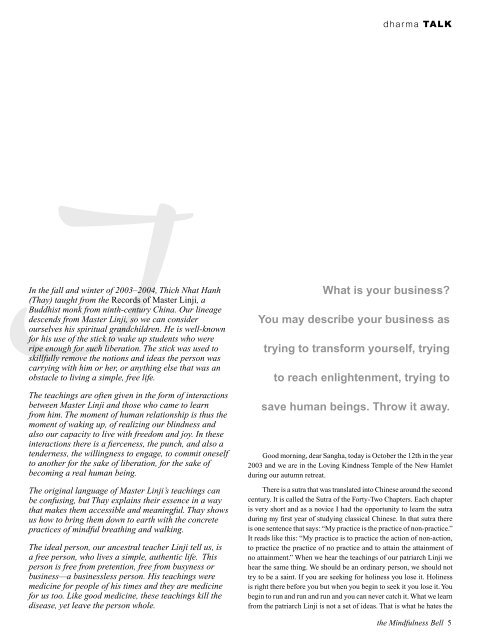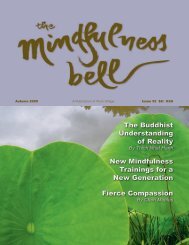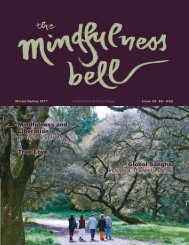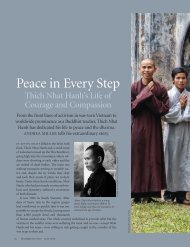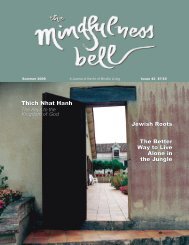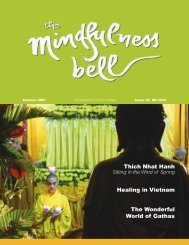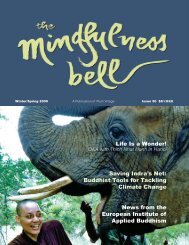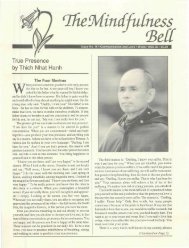View full issue in PDF - The Mindfulness Bell
View full issue in PDF - The Mindfulness Bell
View full issue in PDF - The Mindfulness Bell
- No tags were found...
You also want an ePaper? Increase the reach of your titles
YUMPU automatically turns print PDFs into web optimized ePapers that Google loves.
dhar ma TALK<br />
In the fall and w<strong>in</strong>ter of 2003–2004, Thich Nhat Hanh<br />
(Thay) taught from the Records of Master L<strong>in</strong>ji, a<br />
Buddhist monk from n<strong>in</strong>th-century Ch<strong>in</strong>a. Our l<strong>in</strong>eage<br />
descends from Master L<strong>in</strong>ji, so we can consider<br />
ourselves his spiritual grandchildren. He is well-known<br />
for his use of the stick to wake up students who were<br />
ripe enough for such liberation. <strong>The</strong> stick was used to<br />
skill<strong>full</strong>y remove the notions and ideas the person was<br />
carry<strong>in</strong>g with him or her, or anyth<strong>in</strong>g else that was an<br />
obstacle to liv<strong>in</strong>g a simple, free life.<br />
<strong>The</strong> teach<strong>in</strong>gs are often given <strong>in</strong> the form of <strong>in</strong>teractions<br />
between Master L<strong>in</strong>ji and those who came to learn<br />
from him. <strong>The</strong> moment of human relationship is thus the<br />
moment of wak<strong>in</strong>g up, of realiz<strong>in</strong>g our bl<strong>in</strong>dness and<br />
also our capacity to live with freedom and joy. In these<br />
<strong>in</strong>teractions there is a fierceness, the punch, and also a<br />
tenderness, the will<strong>in</strong>gness to engage, to commit oneself<br />
to another for the sake of liberation, for the sake of<br />
becom<strong>in</strong>g a real human be<strong>in</strong>g.<br />
<strong>The</strong> orig<strong>in</strong>al language of Master L<strong>in</strong>ji’s teach<strong>in</strong>gs can<br />
be confus<strong>in</strong>g, but Thay expla<strong>in</strong>s their essence <strong>in</strong> a way<br />
that makes them accessible and mean<strong>in</strong>gful. Thay shows<br />
us how to br<strong>in</strong>g them down to earth with the concrete<br />
practices of m<strong>in</strong>dful breath<strong>in</strong>g and walk<strong>in</strong>g.<br />
<strong>The</strong> ideal person, our ancestral teacher L<strong>in</strong>ji tell us, is<br />
a free person, who lives a simple, authentic life. This<br />
person is free from pretention, free from busyness or<br />
bus<strong>in</strong>ess—a bus<strong>in</strong>essless person. His teach<strong>in</strong>gs were<br />
medic<strong>in</strong>e for people of his times and they are medic<strong>in</strong>e<br />
for us too. Like good medic<strong>in</strong>e, these teach<strong>in</strong>gs kill the<br />
disease, yet leave the person whole.<br />
What is your bus<strong>in</strong>ess<br />
You may describe your bus<strong>in</strong>ess as<br />
try<strong>in</strong>g to transform yourself, try<strong>in</strong>g<br />
to reach enlightenment, try<strong>in</strong>g to<br />
save human be<strong>in</strong>gs. Throw it away.<br />
Good morn<strong>in</strong>g, dear Sangha, today is October the 12th <strong>in</strong> the year<br />
2003 and we are <strong>in</strong> the Lov<strong>in</strong>g K<strong>in</strong>dness Temple of the New Hamlet<br />
dur<strong>in</strong>g our autumn retreat.<br />
<strong>The</strong>re is a sutra that was translated <strong>in</strong>to Ch<strong>in</strong>ese around the second<br />
century. It is called the Sutra of the Forty-Two Chapters. Each chapter<br />
is very short and as a novice I had the opportunity to learn the sutra<br />
dur<strong>in</strong>g my first year of study<strong>in</strong>g classical Ch<strong>in</strong>ese. In that sutra there<br />
is one sentence that says: “My practice is the practice of non-practice.”<br />
It reads like this: “My practice is to practice the action of non-action,<br />
to practice the practice of no practice and to atta<strong>in</strong> the atta<strong>in</strong>ment of<br />
no atta<strong>in</strong>ment.” When we hear the teach<strong>in</strong>gs of our patriarch L<strong>in</strong>ji we<br />
hear the same th<strong>in</strong>g. We should be an ord<strong>in</strong>ary person, we should not<br />
try to be a sa<strong>in</strong>t. If you are seek<strong>in</strong>g for hol<strong>in</strong>ess you lose it. Hol<strong>in</strong>ess<br />
is right there before you but when you beg<strong>in</strong> to seek it you lose it. You<br />
beg<strong>in</strong> to run and run and run and you can never catch it. What we learn<br />
from the patriarch L<strong>in</strong>ji is not a set of ideas. That is what he hates the<br />
the M<strong>in</strong>dfulness <strong>Bell</strong> 5


